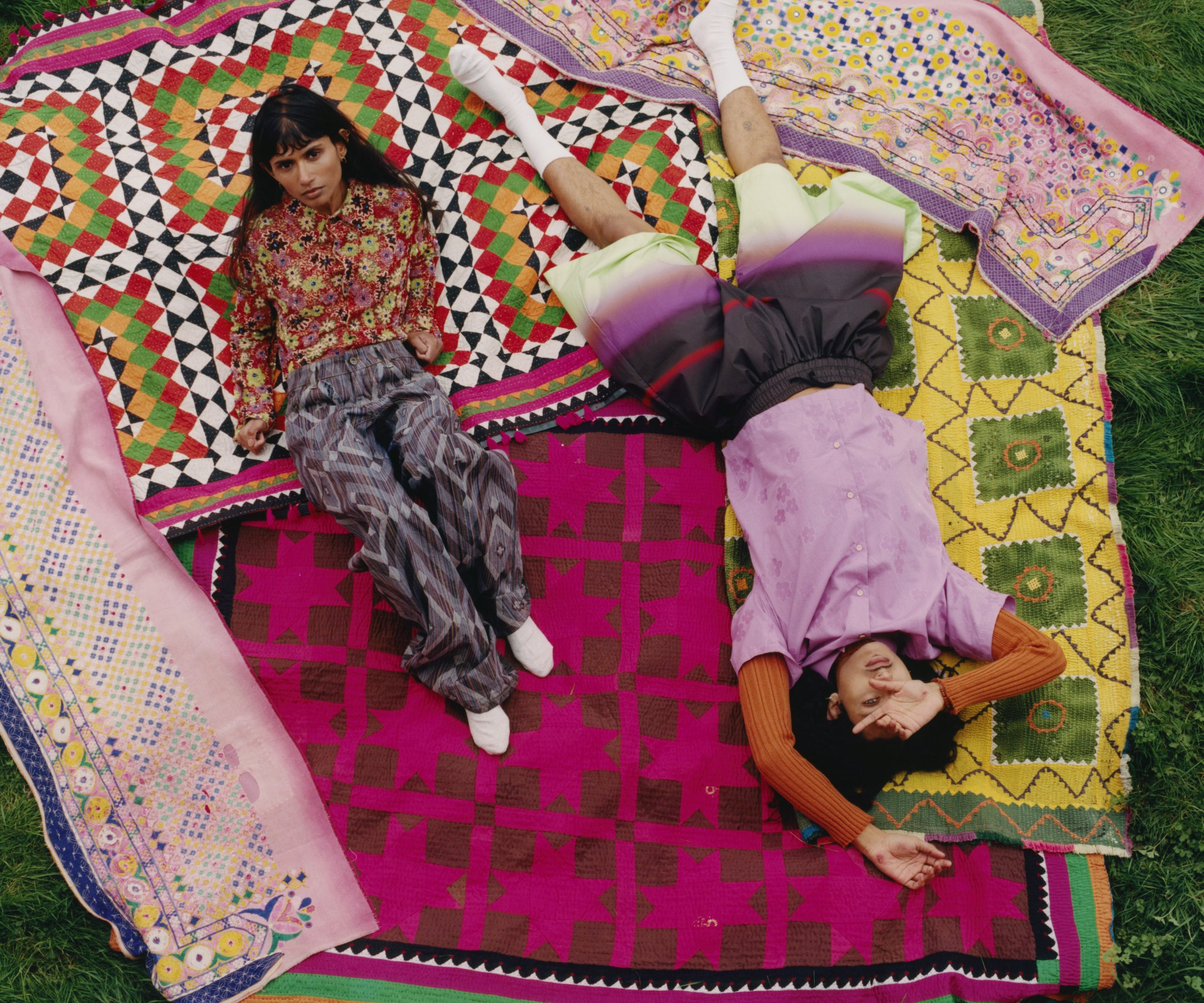Visual Storyteller Tami Aftab explores South Asian textile traditions and diasporic belonging through 'Threads'
Words by Zara Afthab
In Tami Aftab’s new photography series and film Threads, textile traditions, as the name suggests, take centre-stage. Soundtracked by Punjabi folk songs, each frame in Threads is carefully punctuated through the presence of fabric. In some shots, this is seen when the models tie diaphanous chiffons around trees or wrap themselves in a patchwork quilt, and in others, their hands interact directly with the fabric as they pass scraps of multi-coloured fabrics between each other. Commissioned by the British Fashion Council for London Fashion Week’s exhibition spotlighting South Asia’s influence in the fashion industry, Tami’s project is a fitting dedication to a region renowned for its textile history. “I see how increasingly more silhouettes, patterns, and colour palettes that look and feel so inherently South Asian are being used by Western fashion houses without any real acknowledgement or celebration; I wanted to remind people of our aesthetic roots”, explains the London-based image maker who worked on the project as a Photographer and Director.
However, it is not solely South Asia’s centuries-old embroidery techniques that captured Tami’s attention, but additionally how closely these fabrics were linked to her biography. ”I grew up in London, and besides food, my biggest connection to Pakistan, to my own culture, was through fabric and textile,” Tami shares. “Whether that was through the cushion covers and table runners in my family home or the fabrics hanging on the wall, they were all cherished objects that my parents had collected over time or were passed down from family in Pakistan. It’s a habit I’ve taken to my own flat, where I surround myself with fabrics that remind me of my heritage”.
Photography by Tami Aftab
The impulse to adorn your space with textiles is an affliction that I, alongside many South Asians living in the diaspora, share with Tami. During our conversation on the phone, I noticed the pillow covers on my bed that are made of Chanderi silk, my grandfather’s crochet hat that has been fashioned into a lampshade, and the intricately embroidered blanket placed on the end of my bed that was procured from a market in Delhi. As Tami succinctly points out, these household items are sentimental artefacts that gently remind us of our South Asian heritage. In the film, this nostalgia is teased out through the set design by Dalini Sagadeva, who worked on the production design with fabrics from South Asia, hand-me-downs and rugs sourced from JMaybury.
Tami noted that in a dream world, she would have shot the project in South Asia but was determined to transform the suburban London farmhouse to look and feel like a South Asian home. “Dalini had the idea to create these playful backdrops, such as one inspired by washing lines that she pieced together with tie-dye shibori fabrics from South Asia and dupattas borrowed from the stylist’s (Jahnavi Sharma) grandma,” Tami explains. “We wanted to create sets that enhance the fabrics and make them interactive, rather than just a backdrop”. Much like the set design, the intentionality behind each aesthetic choice in Threads, such as the use of a 16mm camera by Anand Singh or the garments sourced by Jahnavi from designers such as Kartik Research and Amesh Wijesekera who are reimagining traditional craft, work seamlessly to push forward Tami’s directorial vision.
Photography by Tami Aftab
At the ICA, where the photographs were displayed between the 7th and 9th of June as part of an exhibition curated by Simran Randhawa, Tami’s mediation on memory, community and cultural belonging was further materialised. As part of the event, Tami and her father, Tony Aftab catered a dinner with a tailor made menu sourced straight from the cookbook they collaboratively created together last year. Tami shared her joy upon seeing the food being shared by the attendees who were reaching over the table to grab pakora-style canapes. “At the event, we managed to find a good balance of making the food look beautiful but still honing in on the joy of sharing that is inherent to South Asian food. It was so beautiful to see people reaching over and putting things on their plate, eating with their hands and thanking “Tony Uncle” for making the food. There was a real sense of community and intimacy in the space that you really only feel at a dinner table in your own home or in the homes of your loved ones”.
Pulling the audience into a moment of intimacy through a photograph is perhaps what Tami’s practice does best. In Threads, you can spot this through the models interactions with each each other. In other personal projects, she often turns her focus onto her father who lives with short term memory loss. “Working with my father on our cookbook The Rice Is On The Hob, where we combined the recipes passed down to my father from family in Pakistan with photographs of him in his neighbourhood growing up, was a culmination of five years of collaborating together,” Tami shares. “I’ve worked on commercial projects with clients I would dream of but despite all that, I always go back to why I started photography in the first place which was to attempt to encapsulate a subject’s whole being into an image and do their story justice”.
Credits:
Director/Photographer - @tamiaftab
Production company - @ameliastudios
Commissioner - @britishfashioncouncil
DOP - @anandsingh_dop
EP - @jamieglydon
Producer - @eloiseskeet
Production manager - @danielleekeane
Lighting assistant - @myphotography1992
Art director - @__dalini
Textiles supplied by @j__maybury
Hair and makeup - @nisha_gulati
Stylist - @jahnavishaarma
Styling assistant - @h.untermitchell
Edit - @haz.greg2 @duck_musings
Grade - @nicholas_paul_dalby @bubbletv
Cast - @maneeshapere @ace777blog @brother.models

